wp3
Conference papers accepted: EUSFLAT
01/09/23/12:17 Filed in: Conference papers
T. Flaminio, Ll. Godo, N. Madrid, M. Ojeda-Aciego. A Logic to Reason About f-Indices of Inclusion over Ł𝑛. Proc. of EUSFLAT 2023.
ABSTRACT In this paper we provide a sound and complete logic to formalise and reason about f-indices of inclusion. The logic is based on finite-valued Lukasiewicz logic and its S5-like modal extension S5(L) with additional unary operators.
Published in Lecture Notes in Computer Science, vol 14069: 530-539, 2023.
M. Ojeda-Hernández, P. Cordero, I.P. Cabrera, E. Muñoz-Velasco. Closure structures as fixed points of some Galois connections. Proc. of EUSFLAT 2023.
Extended abstract published in Book of Abstracts EUSFLAT 2023.
Conference papers accepted: ICCS
01/09/23/12:17 Filed in: Conference papers
C. Bejines, D. López-Rodríguez, M. Ojeda-Hernández. Aggregation Functions and Extent Structure Preservation in Formal Concept Analysis. Proc. of Int. Conf. on Conceptual Structures.
ABSTRACT Formal Concept Analysis (FCA) is a mathematical framework for analysing data tables that capture the relationship between objects and attributes. The concept lattice derived from such a table is a representation of the implicit knowledge about this relationship, where each concept corresponds to a bicluster of objects and attributes. FCA has been widely used for knowledge acquisition and representation, conceptual data analysis, information retrieval and other applications. In this paper, we use an extension of the classical FCA to deal with fuzzy formal contexts, where the relationship between objects and attributes is modelled by truth values indicating the degree to which an object possesses a property or attribute. Fuzzy Formal Concept Analysis (FFCA) allows us to capture vague or imprecise information and handle uncertainty or ambiguity in data analysis. Our purpose is to use aggregation functions in order to manipulate and explore fuzzy formal concepts in different ways depending on the desired properties or criteria. In this work, we will focus on the structure of the extents of the concept lattice. We define the aggregation of fuzzy extents point-wise and study how it affects its structure. We characterise the aggregation functions that preserve the fuzzy extent structure and show that they depend on the number of objects in the context. Our results contribute to a better understanding of how aggregation functions can be used to manipulate and explore fuzzy formal concepts..
Published as Lecture Notes in Computer Science, vol 14133: 28-35, 2023
M. Ojeda-Hernández, I. P. Cabrera, P. Cordero, E. Muñoz-Velasco. On Pseudointents in Fuzzy Formal Concept Analysis. Proc. of Int. Conf. on Conceptual Structures.
ABSTRACT Formal Concept Analysis (FCA) is a mathematical framework for analysing data tables that capture the relationship between objects and attributes. FCA deals with two main structures of knowledge, namely the concept lattice and the basis of attribute implications. There are several sets of implications in the literature, for instance minimal bases, direct bases or direct minimal bases. In this work we are interested in the concept of pseudointent in the fuzzy framework in order to define the Duquenne-Guigues basis in the fuzzy setting.
Published as Lecture Notes in Computer Science, vol 14133: 36-40, 2023
Journal paper accepted: NEUCOMP
07/01/25/12:00 Filed in: Journal paper
I. Perfilieva, N. Madrid, M. Ojeda-Aciego, P. Artiemjew, A. Niemczynowicz. A Critical Analysis of the Theoretical Framework of the Extreme Learning Machine. Neurocomputing, 2025
ABSTRACT Despite several successful applications of the Extreme Learning Machine (ELM) as a new neural network training method that combines random selection with deterministic computation, we show that some fundamental principles of ELM lack a rigorous mathematical basis. In particular, we refute the proofs of two fundamental claims and construct datasets that serve as counterexamples to the ELM algorithm. Finally, we provide alternative claims to the basic principles that justify the effectiveness of ELM in some theoretical cases.
ESTYLF conference organized
We have co-chaired the Spanish Fuzzy Logic and Technology conference (ESTYLF) in Coruña
The most recent edition of the Spanish Conference on Fuzzy Logic and Technology (ESTYLF) has been co-chaired by Manuel Ojeda-Aciego and Jesús Medina (from Univ. Cádiz).
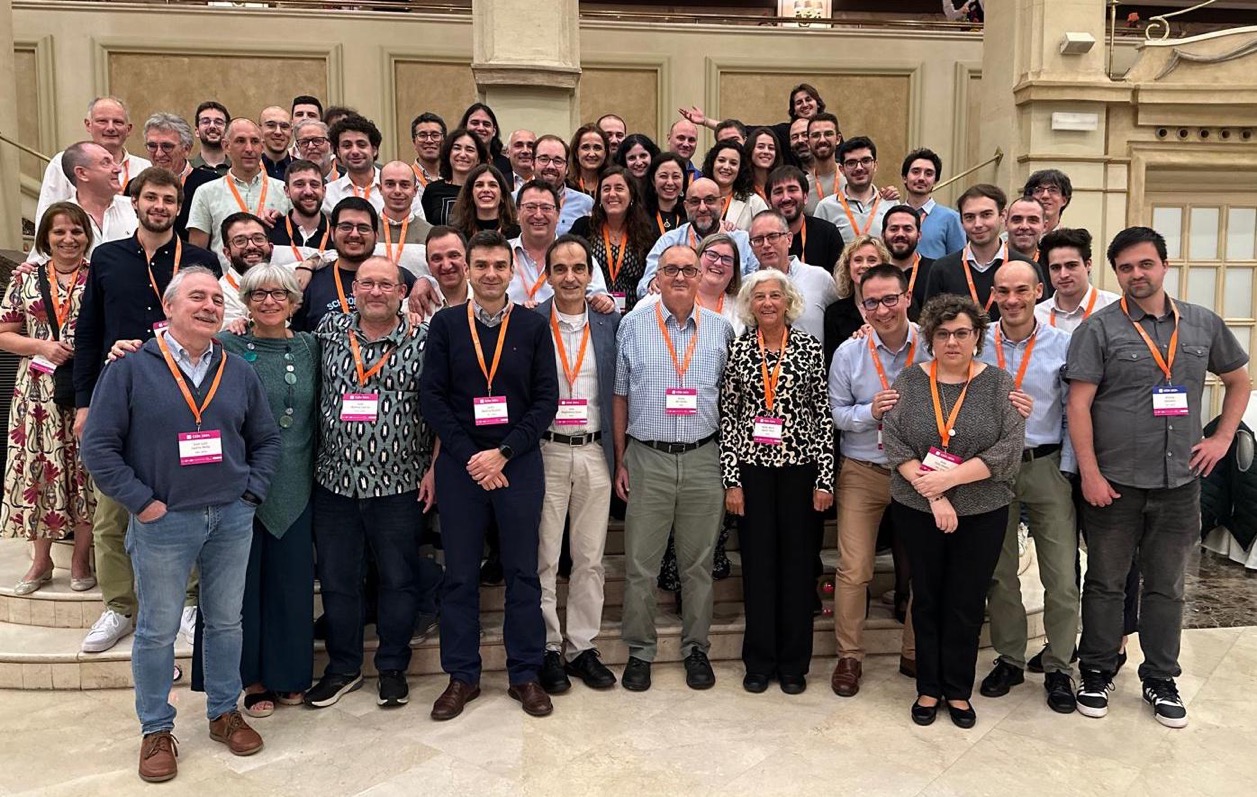
Our group presented three communications:
- F. Pérez-Gámez and C. Bejines. Álgebras de Heyting débiles: una generalización para retículos no distributivos.
- I.P. Cabrera, P. Cordero, E. Muñoz-Velasco and M. Ojeda-Hernández. Estructuras de clausura difusas como puntos fijos de conexiones de Galois.
- N. Madrid and M. Ojeda-Aciego. El f-índice de inclusión como par adjunto óptimo para modus ponens difuso.
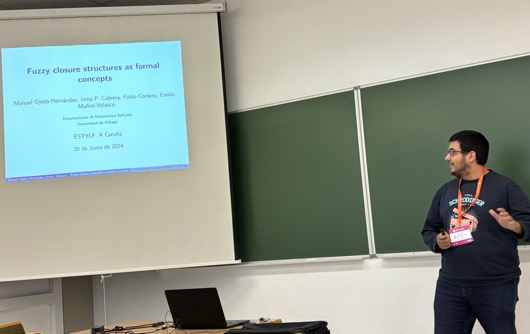
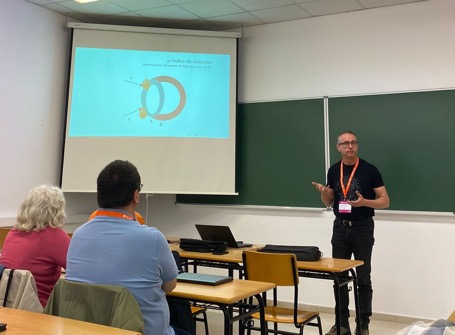
We also participated as co-editors of the proceedings of CAEPIA'24, published by Springer.
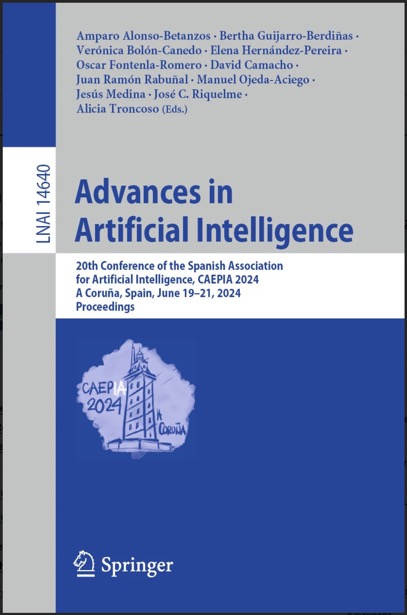
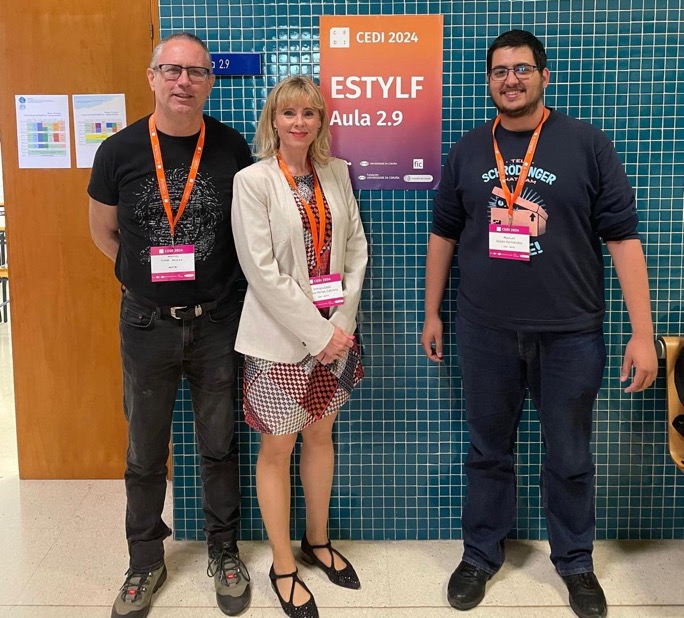
Conference papers accepted: FSTA
30/11/23/13:48 Filed in: Conference papers
O. Krídlo, D. López-Rodríguez, M. Ojeda-Aciego, M. Reformat. An FCA-based approach to RDF graphs. Fuzzy Sets Theory and Applications, FSTA, 2024.
ABSTRACT We investigate building a connection between RDF and FCA. The proposed approach transforms an RDF graph, where vertices represent objects of different types and edges represent relationships between these objects, into a series of bipartite graphs. It is achieved by separating edges representing specific relationships, resulting in a clear representation of the relationship of interest without clutter. To address this issue, we propose a bond-based construction of rigorous and benevolent compositions of bipartite graphs. These bipartite graphs are extracted from RDF graphs and combined—using the proposed construction—with external information related to the graphs' entities.
D. López-Rodríguez, M. Ojeda-Hernández, Á. Mora. Close-by-One strategy for computing the fuzzy concept lattice. Fuzzy Sets Theory and Applications, FSTA, 2024.
ABSTRACT We present the extension of CbO-like algorithms to a native fuzzy environment, without scaling, and combining the advantages of the different algorithms to obtain faster results with less computational load. The soundness of these algorithms is presented together with a comparison with existing strategies to show the improvement in both time, number of intents computed and number of tests performed.
Conference papers accepted EUSFLAT
27/05/25/13:02 Filed in: Conference paper
N. Madrid, M. Ojeda-Aciego. Studying the structure generated by subsets of ƒ-indexes of inclusion.14th Conference of the European Society for Fuzzy Logic and Technology, Riga, 2025.
Key-Work Abstract The ƒ-index of inclusion has proven to be a suitable generalization of the inclusion in the fuzzy setting. In this paper, the properties of the ƒ-index of inclusion, when its definition is restricted to a subset of indexes, are analyzed. The theoretical results obtained in this work are necessary in order to develop fuzzy inference systems based on the ƒ-index of inclusion.
M. Holcapek, N. Cao, R. Valasek, N. Madrid, T. Tichy, D. Nedela. Weighted Quantile Approach to Time Series Forecasting Using Fuzzy-Probabilistic Inference Systems.14th Conference of the European Society for Fuzzy Logic and Technology, Riga, 2025.
Contributed Paper Abstract This talk introduces a novel time series forecasting method based on a fuzzy-probabilistic inference system. The central concept is the use of an IF–THEN rule system, where antecedents are represented by fuzzy sets forming a fuzzy partition of the time domain, and consequents are quantile functions that characterize the conditional distribution of time series values over each antecedent.
M. Ojeda-Hernández, D. López Rodríguez. On direct systems of implications with graded attributes. 14th Conference of the European Society for Fuzzy Logic and Technology, Riga, 2025.
Key-Work Abstract In this paper the problem of defining direct systems of implications in the fuzzy setting is studied. The directness of systems allows a quick computation of the closure operator in cases such as Fuzzy Formal Concept Analysis. Characterizing these properties in algebraic terms is deeply linked to Simplification Logic. After the theoretical results, some thoughts on algorithms to provide direct systems are also considered.
I.P. Cabrera, P. Cordero, B. De Baets, E. Muñoz-Velasco, M. Ojeda-Hernández. Kernel operators on trellises. 14th Conference of the European Society for Fuzzy Logic and Technology, Riga, 2025.
Contributed Paper Abstract In this work, we focus on interesting mathematical structures that are less known than lattices, namely the class of pseudo-ordered set, and in particular the subclass of trellises. We address the study of kernel operators and their counterparts, closure operators, within the general framework of pseudo-ordered sets and trellises. We also explore Galois connections which are intimately linked to those notions.
Key-Work Abstract The ƒ-index of inclusion has proven to be a suitable generalization of the inclusion in the fuzzy setting. In this paper, the properties of the ƒ-index of inclusion, when its definition is restricted to a subset of indexes, are analyzed. The theoretical results obtained in this work are necessary in order to develop fuzzy inference systems based on the ƒ-index of inclusion.
M. Holcapek, N. Cao, R. Valasek, N. Madrid, T. Tichy, D. Nedela. Weighted Quantile Approach to Time Series Forecasting Using Fuzzy-Probabilistic Inference Systems.14th Conference of the European Society for Fuzzy Logic and Technology, Riga, 2025.
Contributed Paper Abstract This talk introduces a novel time series forecasting method based on a fuzzy-probabilistic inference system. The central concept is the use of an IF–THEN rule system, where antecedents are represented by fuzzy sets forming a fuzzy partition of the time domain, and consequents are quantile functions that characterize the conditional distribution of time series values over each antecedent.
M. Ojeda-Hernández, D. López Rodríguez. On direct systems of implications with graded attributes. 14th Conference of the European Society for Fuzzy Logic and Technology, Riga, 2025.
Key-Work Abstract In this paper the problem of defining direct systems of implications in the fuzzy setting is studied. The directness of systems allows a quick computation of the closure operator in cases such as Fuzzy Formal Concept Analysis. Characterizing these properties in algebraic terms is deeply linked to Simplification Logic. After the theoretical results, some thoughts on algorithms to provide direct systems are also considered.
I.P. Cabrera, P. Cordero, B. De Baets, E. Muñoz-Velasco, M. Ojeda-Hernández. Kernel operators on trellises. 14th Conference of the European Society for Fuzzy Logic and Technology, Riga, 2025.
Contributed Paper Abstract In this work, we focus on interesting mathematical structures that are less known than lattices, namely the class of pseudo-ordered set, and in particular the subclass of trellises. We address the study of kernel operators and their counterparts, closure operators, within the general framework of pseudo-ordered sets and trellises. We also explore Galois connections which are intimately linked to those notions.
Intl Seminar Participation
04/12/24/21:00 Filed in: seminar
M. Ojeda-Aciego. On the ƒ-index of inclusion: what is it? what is it good for? Seminar of AI of the Mathematical Institute of the Serbian Academy of Sciences and Arts .
We had the pleasure to participate at the Artificial Intelligence Seminar of the Mathematical Institute of the Serbian Academy of Sciences and Arts.
A number of interesting lines for further research were raised in the discussion following the presentation.
Thanks to Andreja Tepavcevic for the invitation.
ABSTRACT
The notion of inclusion is a cornerstone of set theory and therefore its generalisation in fuzzy set theory is of great interest. The functional degree (or φ-degree) of inclusion is defined to represent the degree of inclusion between two L-fuzzy sets in terms of a mapping that determines the minimal modifications required in one L-fuzzy set to be included in another in the sense of Zadeh. Thus, this notion differs from others existing in the literature because the φ-degree of inclusion is considered as a mapping instead of a value in the unit interval. We show that the φ-degree of inclusion satisfies versions of many common axioms usually required for inclusion measures in the literature.
Considering the relationship between fuzzy entropy and Young's axioms for measures of inclusion, we also present a measure of entropy based on the φ-degree of inclusion that is consistent with the axioms of De Luca and Termini. We then further study the properties of the φ-degree of inclusion and show that, given a fixed pair of fuzzy sets, their φ-degree of inclusion can be linked to a fuzzy conjunction that is part of an adjoint pair. We also show that when this pair is used as the underlying structure to provide a fuzzy interpretation of the modus ponens inference rule, it provides the maximum possible truth value in the conclusion among all those values obtained by fuzzy modus ponens using any other possible adjoint pair. Finally, we will focus on current work on the integration of the φ-degree of inclusion with FCA.
We had the pleasure to participate at the Artificial Intelligence Seminar of the Mathematical Institute of the Serbian Academy of Sciences and Arts.
A number of interesting lines for further research were raised in the discussion following the presentation.
Thanks to Andreja Tepavcevic for the invitation.
ABSTRACT
The notion of inclusion is a cornerstone of set theory and therefore its generalisation in fuzzy set theory is of great interest. The functional degree (or φ-degree) of inclusion is defined to represent the degree of inclusion between two L-fuzzy sets in terms of a mapping that determines the minimal modifications required in one L-fuzzy set to be included in another in the sense of Zadeh. Thus, this notion differs from others existing in the literature because the φ-degree of inclusion is considered as a mapping instead of a value in the unit interval. We show that the φ-degree of inclusion satisfies versions of many common axioms usually required for inclusion measures in the literature.
Considering the relationship between fuzzy entropy and Young's axioms for measures of inclusion, we also present a measure of entropy based on the φ-degree of inclusion that is consistent with the axioms of De Luca and Termini. We then further study the properties of the φ-degree of inclusion and show that, given a fixed pair of fuzzy sets, their φ-degree of inclusion can be linked to a fuzzy conjunction that is part of an adjoint pair. We also show that when this pair is used as the underlying structure to provide a fuzzy interpretation of the modus ponens inference rule, it provides the maximum possible truth value in the conclusion among all those values obtained by fuzzy modus ponens using any other possible adjoint pair. Finally, we will focus on current work on the integration of the φ-degree of inclusion with FCA.
Journal paper accepted: MATHS
01/01/25/10:47 Filed in: Journal paper
D. López-Rodríguez, M. Ojeda-Hernández, and C. Bejines. New Simplification Rules for Databases with Positive and Negative Attributes. Mathematics 13.2 (2025). ABSTRACT In this paper, new logical equivalences are presented within the simplification logic with mixed attributes paradigm, which allow the obtention of bases of shorter, easier-to-read attribute implications. In addition to the theoretical results which show that the proposed equivalences indeed hold in simplification logic with mixed attributes, experimental results which showcase the effectiveness of this method are also provided. Furthermore, the simplification method presented is iterative and gives sufficiently good results in only one or two iterations, therefore presenting itself as a reasonable procedure in time-sensitive experiments.
Participation HARMONIC'23
22/10/23/10:14 Filed in: Workshop participation
Fuzzy Formal Tools for Non Canonical Reasoning (HARMONIC), Osuna, October 19-22, 2023
Herramientas Difusas Para el Razonamiento No Canónico (HARMONIC) was the original name of the workshop, which is now turn into international.
It was held in the very nice village of Osuna (Seville).
Our group presented the findings in the three different research lines below:
* Manuel Ojeda-Aciego: Formal context-based approach to expand RDF data.
* Carlos Bejines: Aggregation Functions on Fuzzy Vector Spaces..
* Manuel Ojeda-Hernández: Quasi closed elements via closure systems.
Journal paper accepted KBS
23/04/25/11:48 Filed in: Journal paper
D. López, M. Ojeda-Hernández, T. Pattison. Systems of implications obtained using the Carve decomposition of a formal context. Knowledge-based systems, 318:113475, 2025.
ABSTRACT The Carve algorithm uses a divide-and-conquer strategy to compute the concept lattice of a formal context. The decomposition phase of the Carve algorithm discovers hierarchical structure in an amenable formal context, which the synthesis phase then exploits to construct the concept lattice from those of the component sub-contexts. In this paper, the problem of computing a sound and complete set of attribute implications via a refinement of the Carve decomposition is studied. Indeed, a set of rules is devised to obtain a set of valid implications which is proved to be complete. The refined decomposition and these rules are implemented in the novel Carve+ algorithm, whose runtime compares favorably with direct computation of the Duquenne–Guigues base of implications via the NextClosure algorithm.
ABSTRACT The Carve algorithm uses a divide-and-conquer strategy to compute the concept lattice of a formal context. The decomposition phase of the Carve algorithm discovers hierarchical structure in an amenable formal context, which the synthesis phase then exploits to construct the concept lattice from those of the component sub-contexts. In this paper, the problem of computing a sound and complete set of attribute implications via a refinement of the Carve decomposition is studied. Indeed, a set of rules is devised to obtain a set of valid implications which is proved to be complete. The refined decomposition and these rules are implemented in the novel Carve+ algorithm, whose runtime compares favorably with direct computation of the Duquenne–Guigues base of implications via the NextClosure algorithm.
Journal paper accepted MATHEMATICS
12/06/25/11:03 Filed in: Journal paper
C. Díaz-Montarroso, N. Madrid, E. Ramírez-Poussa. Correctness of Fuzzy Inference Systems Based on f-Inclusion. Mathematics 2025, 13, 1897.
ABSTRACT Recent work has shown that the f -index of inclusion can serve as a foundation for modeling Generalized Modus Ponens. In this paper, we develop a novel fuzzy inference system based on this inference rule. To establish its soundness, we connect it to a Fuzzy Description Logic LU enriched with fuzzy modifiers (also known as fuzzy hedges). This logic background provides to the approach a strength absent in most fuzzy inference systems in the literature, which allows us to formally prove a series of results that culminate in a final correctness theorem for the proposed fuzzy inference system. This paper also presents a running example aimed at showing the potential applicability of the proposal.
ABSTRACT Recent work has shown that the f -index of inclusion can serve as a foundation for modeling Generalized Modus Ponens. In this paper, we develop a novel fuzzy inference system based on this inference rule. To establish its soundness, we connect it to a Fuzzy Description Logic LU enriched with fuzzy modifiers (also known as fuzzy hedges). This logic background provides to the approach a strength absent in most fuzzy inference systems in the literature, which allows us to formally prove a series of results that culminate in a final correctness theorem for the proposed fuzzy inference system. This paper also presents a running example aimed at showing the potential applicability of the proposal.
Participation WoFTU'24
12/02/24/13:00 Filed in: Workshop participation
Workshop on Formal Treatment of Uncertainty in Knowledge-Based Systems, Cádiz, February 8-11, 2024
This workshop is focused on creating synergies between academia, industry and third party partners to promote new challenges and projects in the framework of uncertainty in Artificial Intelligence.
We participated with two contributions and one tutorial:
Tutorial: Domingo López. fcaR, Formal Concept Analysis with R.
* Carlos Bejines: Aggregation Functions for uncertainty management.
* Domingo López: Concept lattice-based polarity analysis in texts.
* Manuel Ojeda-Aciego: f-inclusion for the design of deductive automatic systems.
Participation CONCEPTS'24
14/09/24/11:49 Filed in: Conference participation
International Joint Conference on Conceptual Knowledge Structures 2024
Just back from CONCEPTS'24, the first joint event of the three main conferences on Formal Concept Analysis, namely, ICFCA, CLA and ICCS.
This first edition was held in Cadiz, in the Aulario La Bomba, an old barracks that is now used as a conference centre and exhibition hall by the University of Cadiz.
Our research team participated with seven communications.
- Nicolás Madrid presented Towards a generalized modus ponens based on the φ-index of inclusion.
- Domingo López-Rodríguez presented Rearrangement of fuzzy formal contexts for reducing cost of algorithms.
- Our external collaborator Ondrej Krídlo presented Connecting concept lattices with bonds between L-fuzzy formal contexts by external information.
- Our colleague Inma P. Cabrera presented Fuzzy relational Galois connections between fuzzy transitive digraphs, joint work with Emilio Muñoz-Velasco, Manuel Ojeda-Aciego and others.
- M. Ojeda-Hernández presented Obtaining the necessary concepts in a partial formal context.
- Carlos Bejines presented Aggregation of fuzzy graphs.
- Our colleague Fran Valverde presented Progress in Formal Context Transforms, joint work with Manuel Ojeda-Aciego and others.

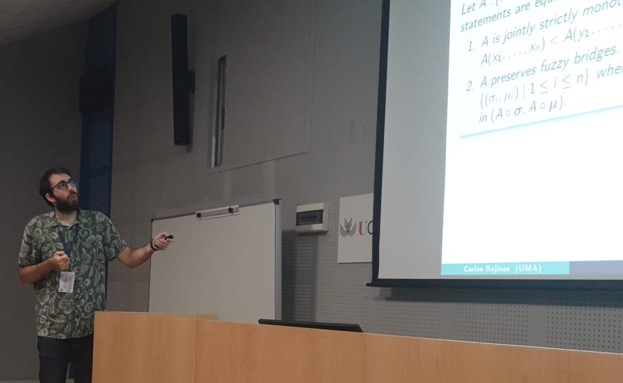
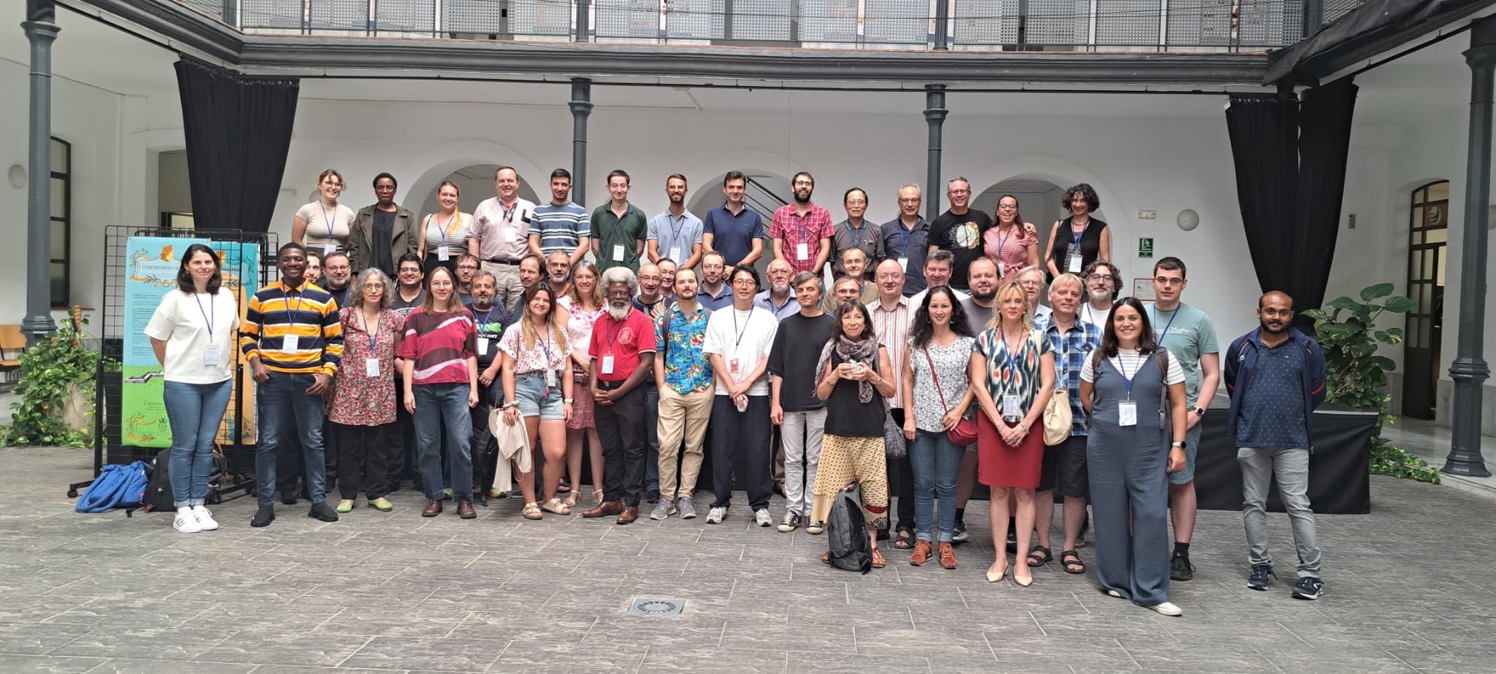
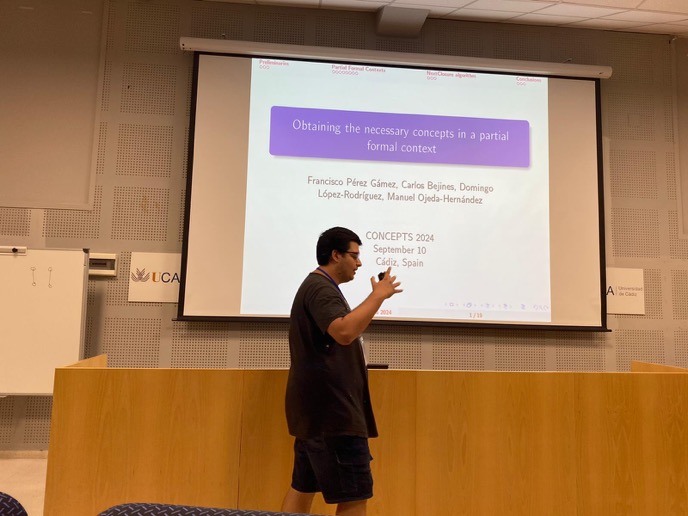
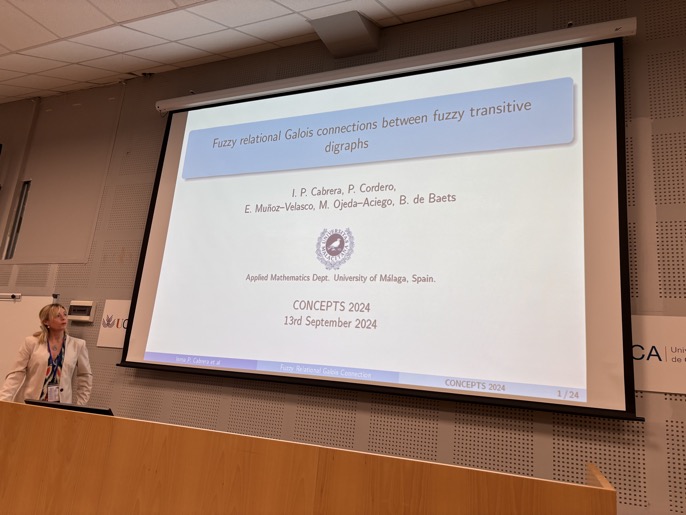
Participation ESCIM'25
26/05/25/11:21 Filed in: Conference participation
European Symposium on Computational Intelligence and Mathematics, ESCIM, Coruña, Spain, May 18-21, 2025
A well-attended conference in which our team presented two keyworks and one position paper. The titles of the talks were "Composition as a fuzzy conjunction between indexes of inclusion", "New simplification rules for databases with positive and negative attributes" and "Unfiltered Large Language Models: Forensic and Legal Challenges of their Criminal Use on the Dark Web: a preliminary study".
We had the opportunity to meet again a number of colleagues, Vilém Novák, Vladik Kreinovich, László Koczy, Francesc Esteva, Juan Moreno, and Jesús Medina among others, in order to discuss prospects of future work or continue the existing ones. In the picture, our team members and after de gala dinner with Irina Perfilieva (external member) and Vilém Novák.
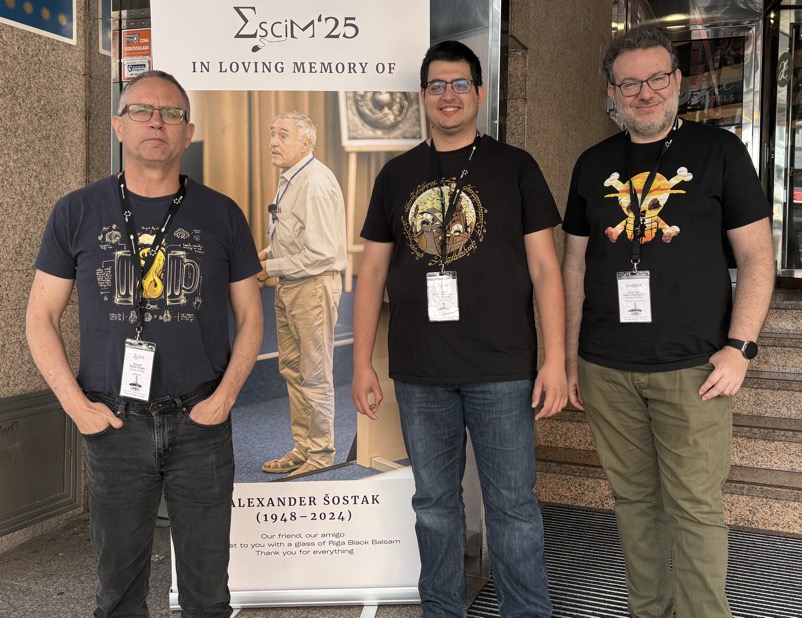
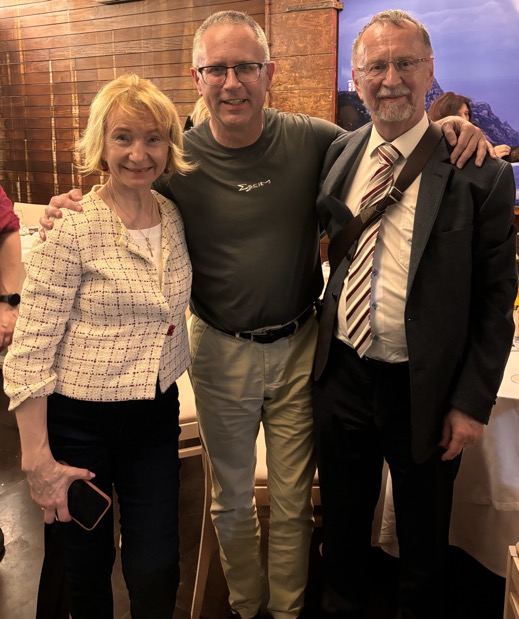
Conference papers accepted ESTYLF
17/04/24/10:15 Filed in: Conference papers
Francisco Pérez-Gámez and Carlos Bejines. Álgebras de Heyting débiles: una generalización para retículos no distributivos. Congreso Español de Tecnología y Lógica Difusa (ESTYLF), Coruña, 2024.
ABSTRACT En este artículo se presentan las álgebras de Heyting débiles. Estas álgebras constituyen una extensión del álgebra de Heyting adaptada a retículos no distributivos. Fijado un retículo, se enumeran condiciones que garantizan la existencia de estas álgebras. Además, se caracterizan en función de los operadores de implicación y se acota su rango.
I.P. Cabrera, P. Cordero, E. Muñoz-Velasco and M. Ojeda-Hernández. Estructuras de clausura difusas como puntos fijos de conexiones de Galois. Congreso Español de Tecnología y Lógica Difusa (ESTYLF), Coruña, 2024.
ABSTRACT Las conexiones de Galois parecen estar omnipresentes en las matemáticas. Se han utilizado para modelizar soluciones de problemas tanto puros como orientados a aplicaciones. A lo largo del artículo, el marco general es un retículo completo difuso sobre un retículo residuado completo. En este trabajo, se estudia la existencia de conexiones difusas de Galois (antítonas e isótonas) entre cuatro conjuntos ordenados específicos. Lo más interesante es que los sistemas de cierre difusos, los operadores de cierre difusos y las relaciones de cierre difusas fuertes son conceptos formales (puntos fijos) de estas conexiones de Galois difusas..
N. Madrid and M. Ojeda-Aciego. El f-índice de inclusión como par adjunto óptimo para modus ponens difuso. Congreso Español de Tecnología y Lógica Difusa (ESTYLF), Coruña, 2024.
ABSTRACT Continuamos estudiando las propiedades del f-índice de inclusión y mostramos que, dado un par fijo de conjuntos difusos, su f-índice de inclusión puede vincularse a una conjunción difusa que forma parte de un par adjunto. También mostramos que, cuando este par se utiliza como estructura subyacente para proporcionar una interpretación difusa de la regla de inferencia modus ponens, proporciona el máximo valor de verdad posible en la conclusión entre todos los valores obtenidos por modus ponens difuso utilizando cualquier otro par adjunto posible.
ABSTRACT En este artículo se presentan las álgebras de Heyting débiles. Estas álgebras constituyen una extensión del álgebra de Heyting adaptada a retículos no distributivos. Fijado un retículo, se enumeran condiciones que garantizan la existencia de estas álgebras. Además, se caracterizan en función de los operadores de implicación y se acota su rango.
I.P. Cabrera, P. Cordero, E. Muñoz-Velasco and M. Ojeda-Hernández. Estructuras de clausura difusas como puntos fijos de conexiones de Galois. Congreso Español de Tecnología y Lógica Difusa (ESTYLF), Coruña, 2024.
ABSTRACT Las conexiones de Galois parecen estar omnipresentes en las matemáticas. Se han utilizado para modelizar soluciones de problemas tanto puros como orientados a aplicaciones. A lo largo del artículo, el marco general es un retículo completo difuso sobre un retículo residuado completo. En este trabajo, se estudia la existencia de conexiones difusas de Galois (antítonas e isótonas) entre cuatro conjuntos ordenados específicos. Lo más interesante es que los sistemas de cierre difusos, los operadores de cierre difusos y las relaciones de cierre difusas fuertes son conceptos formales (puntos fijos) de estas conexiones de Galois difusas..
N. Madrid and M. Ojeda-Aciego. El f-índice de inclusión como par adjunto óptimo para modus ponens difuso. Congreso Español de Tecnología y Lógica Difusa (ESTYLF), Coruña, 2024.
ABSTRACT Continuamos estudiando las propiedades del f-índice de inclusión y mostramos que, dado un par fijo de conjuntos difusos, su f-índice de inclusión puede vincularse a una conjunción difusa que forma parte de un par adjunto. También mostramos que, cuando este par se utiliza como estructura subyacente para proporcionar una interpretación difusa de la regla de inferencia modus ponens, proporciona el máximo valor de verdad posible en la conclusión entre todos los valores obtenidos por modus ponens difuso utilizando cualquier otro par adjunto posible.
